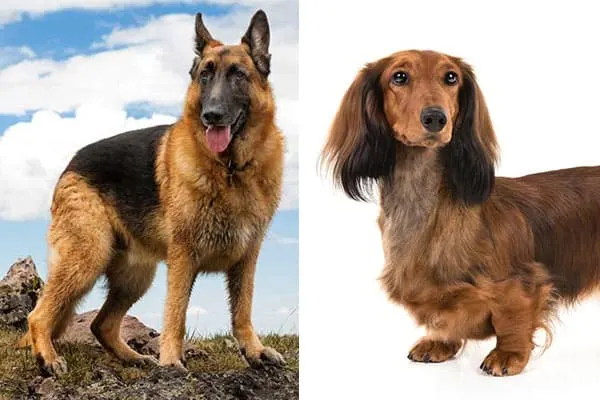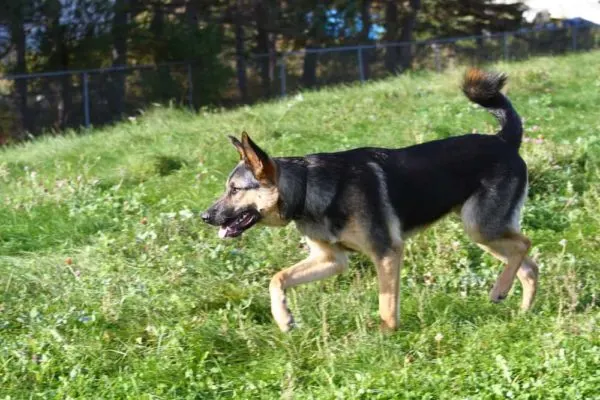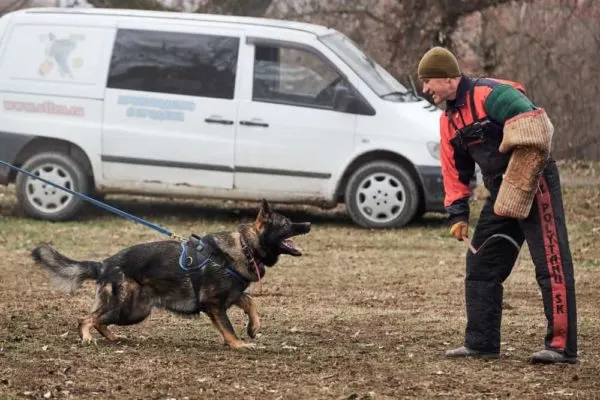German Shepherd Dachshund Mix: Fierce, Feisty and Full of Fun
If you think you’ve never seen anything cuter than a German Shepherd or a Dachshund, get prepared for this mix – the German Shepherd Dachshund dog.
Cute as adults and even cuter when they are puppies, this hybrid mix dog breed draws traits from two of the world’s most popular dog breeds to create an irresistible mix.
Of course, it is harder to know exactly what to expect with a hybrid dog breed. This is because there is no surefire way to predict which traits from each parent dog a given puppy will inherit (although there are some known safeguards we will discuss).
So now let’s dive in and start learning about the fierce, feisty and most of all fun German Shepherd Dachshund mix dog!

But First, A Word About Hybrid Dog Breeds
If you are not sure what a hybrid dog breed even is, you are not alone. Many people get hybrid dogs and mixed breed dogs confused. This is normal and natural.
A mixed-breed dog, or “mutt,” may have two, three or many dog breeds influencing that dog’s appearance, health, behavior, and temperament.
A purebred dog breed, on the other hand, comes from a long and carefully managed breeding program that has standardized the dog’s DNA to certain appearance and temperament traits.
A hybrid dog breed falls somewhere in between. Why breed hybrid dogs, you might ask? Because there can be genetic and health advantages to adding more diversity to one or both purebred parent dogs’ gene pools.
This is the case with all hybrid dog breeding programs today, and the German Shepherd Dachshund mix is the beneficiary of this type of breeding program.
German Shepherd Dachshund Mix: A Short History of Each Parent Dog
The very best way to learn about all the possible traits your dog might inherit is to first learn about each parent dog, which in this case means learning about the German Shepherd and the Dachshund.
German Shepherd: a brief history
According to AKC, The German Shepherd hails from Germany, as this dog’s breed name indicates. Today, the German Shepherd, or GSD, is the second most popular purebred dog breed in the United States (out of nearly 200 registered breeds).
German Shepherd dogs were originally bred to serve alongside humans as livestock and guard dogs. They then became a popular choice for military and police work, eventually becoming prized for search and rescue, security, therapy, and agility.
Today, the German Shepherd is still a true working dog breed through and through but is increasingly chosen as a companion canine as well.

Dachshund: a brief history
According to AKC, The Dachshund dog also hails from Germany and is currently the 12th most popular purebred dog breed in the United States.
These iconic “sausage dogs” or “hot dogs” are truly deserving of the term “tiny but mighty.” While they look like pampered pups, the Dachshund was originally bred for a specific type of hunting work.
Dachshunds are formidable ground hunters, using their small, powerful front legs to dig and tunnel into the earth after badgers and equally powerful jaws and hind legs to drag their prey back out again.
But badgers weren’t the Dachshund’s only prey. Packs of hunting Dachshunds were often used to bring down wild boar!
The original Dachshund dog was standard in size and had a unique wiry coat built to protect the dog while running through brambles, briars, and dense undergrowth.
Today, Dachshunds are bred in three sizes: standard, miniature, and toy. They have three coat types: wiry, smooth and long.
German Shepherd Dachshund Mix: Personality and Temperament
The best way to learn more about any trait for a hybrid dog breed is to study the predominant traits in each purebred parent dog. This is the most accurate predictor for which traits your German Shepherd Dachshund mix puppy might inherit.
The German Shepherd is often described as affectionate, loyal and loving with “their” people but aloof and naturally wary of strangers, whether people or pets.
This befits the GSD’s longstanding role as a guardian, guard and service dog.
The Dachshund is known to have a feisty and fierce temperament with the bravery to boot. But with “their” people, Dachshunds can be devoted to the point of clinginess, even through their famous stubbornness.
Dachshunds are small in size but big in the bark and make excellent guard dogs. Overall, standard Dachshunds tend to be calmer in temperament than their miniature and toy peers.
From this overview, we can learn that your German Shepherd Dachshund mix dog is likely to make an excellent guard and watchdog who will bark readily to warn you of any new developments.
The German Shepherd Dachshund will be reliably wary of strangers, whether people or animals, but devoted and loving towards you.

German Shepherd Dachshund Mix: Size, Height and Weight
If there is one area where the German Shepherd and the Dachshund couldn’t be more different, it is probably in size, height, and weight!
To that end, it can almost boggle the mind that any breeder thought to breed these two dogs together in the first place.
For this reason, if you have very specific size requirements for your next companion canine, the best way to get a better sense of your puppy’s adult size is to work with an F1b or later (F2, F3, et al) hybrid dog breeder.
The German Shepherd dog fits into the large dog category. Adult German Shepherd dogs can easily weigh 50 to 90 pounds and stand 22 to 26 inches tall (paw pad to shoulder).
Adult male GSDs typically stand taller and weigh more than adult female GSDs.
Because the Dachshund is bred in three different sizes today, it is important to learn everything you can about the parents of your hybrid GSD Dachshund puppy.
Dachshunds are bred in three sizes: standard, miniature, and toy (only standard and miniature are recognized by the American Kennel Club). Their weight can range from less than eight pounds to 30+ pounds.
Dachshunds have a type of genetic dwarfism. It is this that causes their extremely short legs. Typically an adult Dachshund will stand less than nine inches tall (paw to shoulder).
So as you can see, correctly guessing the adult size of your German Shepherd Dachshund mix dog can feel like playing the lottery.
In most cases, however, you will see a breeder using the standard Dachshund as a breeding dog.
This means your GSD Dachshund puppy will most likely weigh between 30 and 70 pounds and stand less than 22 inches tall.

German Shepherd Dachshund Mix: Training and Exercise Needs
While both the German Shepherd and the Dachshund dog are bred to hunt, guard and be active, the Dachshund’s short legs and stubborn temperament means these dogs need a different approach to exercise and training.
The German Shepherd may be aloof with strangers, but these dogs are intensely people-centric and eager to please “their” people, which can make them easier to train.
GSDs are incredible athletes and need a lot of daily activity, exercise, and play. These dogs are true working dogs who fare best when they have a job to do or involvement in canine athletics to give them an outlet for all that energy.
The Dachshund’s short legs and long back means these active dogs need some special safeguards to avoid injury. You should never let a Dachshund jump up or down from the furniture or walk up and downstairs.
Dachshunds have an independent streak born from their work as independent hunting and digging dogs. However, they respond very well to positive reinforcement and tend to be very food-motivated, which can be a great help during training.
You can expect your German Shepherd Dachshund mix dog to enjoy an activity and play daily. If your dog takes more after the GSD parent, you may find yourself with a very active dog on your hands who needs a lot of exercises to avoid becoming destructive.
If your dog takes more after the Dachshund parent, you may see a bit more stubbornness during training, although regular infusions of tasty treats will likely take care of the issue.

German Shepherd Dachshund Mix: Shedding, Coat, and Grooming Needs
This is another area where the German Shepherd Dachshund mix dog can surprise owners because while the GSD coat is standardized, the Dachshund is bred in three different coat types, wire-haired, smooth shorthaired and smooth long-haired.
The German Shepherd dog has a thick, double-layer coat that has been developed to serve a very specialized purpose.
The outer layer of the GSD coat is thick, medium-length, coarse and water-resistant. The inner layer is very fine, soft, thick and insulating.
Once to twice per year, the German Shepherd undergoes event owners call the “coat blow.” As you may have guessed, this is a period of intense shedding that owners often liken to a snowfall of dog hair!
The GSD also sheds more moderately year-round. They don’t need a lot of grooming or bathing, but you will do a lot of vacuuming.
The Dachshund coat is a single layer (smooth-hair) or double-layer (wire-hair). The long coat needs the most brushing and grooming, but none of the three coat types sheds all that much and the Dachshund generally emits minimal body odor.
Pairing the German Shepherd with the Dachshund delivers a lot of questions in attempting to predict what your hybrid dog’s adult coat will be like!
Finding out what coat type the Dachshund parent dog has can give you a heads-up, of course. If the pairing is with a wire-haired Dachshund, you can count on a double layer coat and likely more shedding and brushing to go with it.
German Shepherd Dachshund Mix: Health and Longevity
Another area where the German Shepherd and the Dachshund dog breeds tend to differ markedly is in longevity. Health-wise, each breed has specific known genetic health issues it is good to be aware of.
Healthwise, the Canine Health Information Center (CHIC) database states that the GSD should be pre-tested for hip and elbow dysplasia, cardiac, eye issues, autoimmune thyroiditis, temperament, and degenerative myelopathy.
German Shepherds are big dogs and have an average longevity of 7 to 10 years.
Healthwise, the Canine Health Information Center (CHIC) database states that Dachshund breeding dogs should be pre-tested for patellar luxation (trick kneecap), congenital deafness, eye issues (including Progressive Retinal Atrophy, or PRA) and autoimmune thyroiditis.
Dachshunds are small dogs and have an average longevity of 12 to 16 years.
It is very difficult to predict the overall life expectancy of this mix breed dog. Your pup could live anywhere from 7 to 16 years, although the hybrid breeding program itself is likely to improve the life expectancy in an upwards direction.
You can know from the CHIC database results to should make sure the breeder you work with screens for joint issues (knee, elbow, hip), eye and ear issues, thyroid conditions, and temperament.
German Shepherd Dachshund Mix: Is This Your Next Pet Dog?
Is the German Shepherd Dachshund mix a good fit for your lifestyle and family? Perhaps this blend of two iconic and wonderful purebred dog breeds will be your next companion canine!
Recommended reading: The Dachshund Australian Shepherd Mix






























